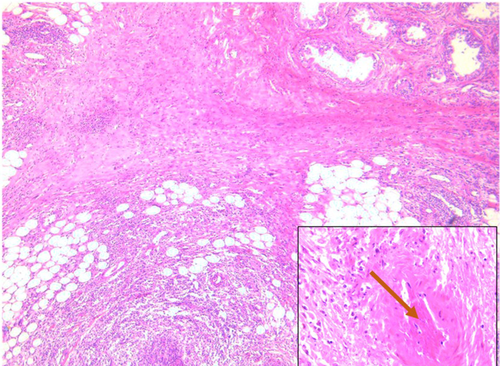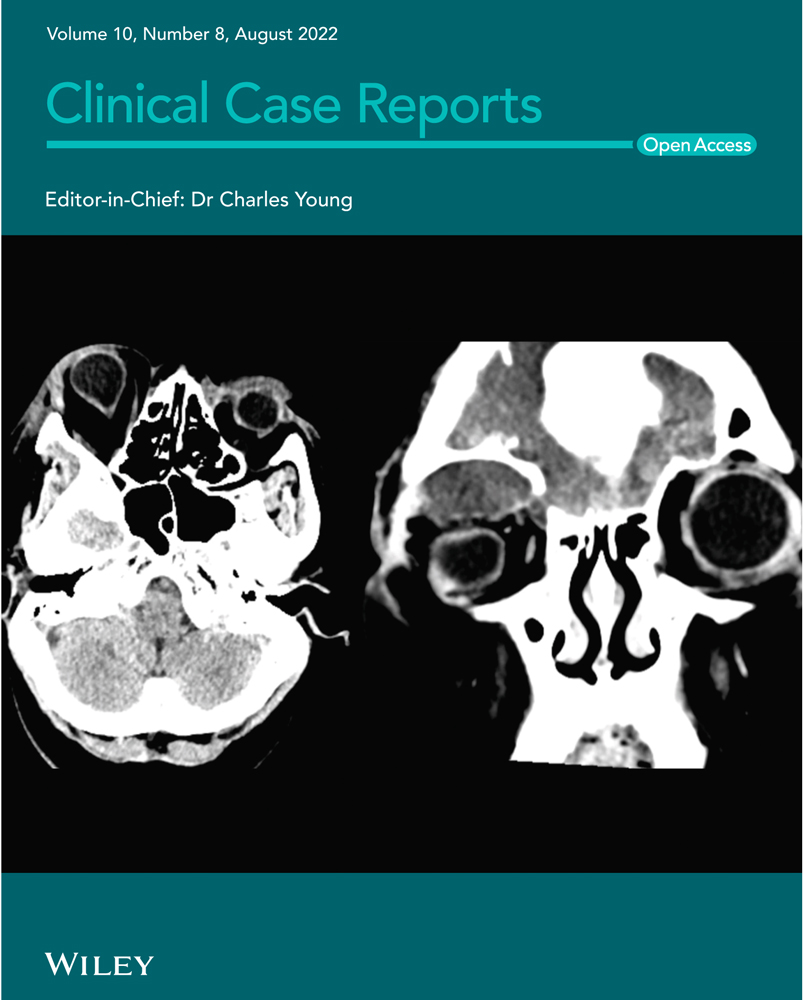Simultaneous testicle and epididymis vasculitis revealing granulomatosis with polyangiitis
Abstract
Granulomatosis with polyangiitis (GPA) is a systemic necrotizing granulomatous vasculitis, which predominantly affects small-sized blood vessels. We aimed to report a case of GPA involving testicles and epididymis taken for malignancy. A 75-year-old patient was admitted for a painful left testicular mass. There was no extra urogenital manifestations on examination and the workup was unremarkable. Histological findings after orchidectomy revealed granulomatous inflammation of the testis and epididymis with fibrinoid necrosis and necrotic vasculitis consisting with the diagnosis of GPA. Further investigations regarding ear, nose, throat, pulmonary, and renal involvement were negative. Proteinase 3 antineutrophil cytoplasmic antibodies (PR3-ANCA) test was negative. Furthermore, infectious diseases especially tuberculosis were ruled out. Based on histopathological findings, limited GPA was diagnosed. The patient was treated with methotrexate and prednisone with good outcome. There was no relapse after 1 year of follow-up. Isolated urogenital involvement may occur at the onset of GPA and can be taken for malignancy. Histopathological findings are the gold standard for the diagnosis. Treatment is based on steroids and immunosuppressive drugs.
1 INTRODUCTION
Granulomatosis with polyangiitis (GPA) is a necrotizing vasculitis of the medium and small vessels.1, 2 It is a rare disease affecting mostly patients between 45 and 60 years with no sex predominance.3 GPA is characterized with a classic triad of upper and lower respiratory tract manifestations in addition to focal segmental glomerulonephritis.2 Ocular involvement as well as skin manifestations, central nervous system, heart and joints can also be affected.2 Although systemic, GPA rarely affects urogenital tract which occurs in less than 1% of the cases.3 Testicles and epididymis involvement can be taken for malignancy when occurring at disease onset.
We herein report the case of a patient who underwent an orchidectomy for an inflammatory testicle mass. Histopathological findings were consisting with GPA affecting simultaneously testicles and epididymis.
2 CASE REPORT
A seventy-five-year-old diabetic patient was admitted for a painful left testicular mass. The patient had no history of fever, night sweating, weight loss, or genito-urinary symptoms. On examination, he was afebrile with inflammatory swollen left testicle. There was a tender irregular mass of 2 cm in size of the upper pole of the left testicle. The rest of the examination was unremarkable as well as workup. Erythrocyte sedimentation rate and C-reactive protein were 30 mm and 12 mg/L, respectively. Ultrasonography showed a mass of 2 cm in diameter at the head of the left testicle. Histological examination of testis tissue after orchidectomy revealed granulomatous inflammation of the testis and epididymis with fibrinoid necrosis (Figure 1). There was also necrotic vasculitis of the wall of the small vessels which were surrounded by altered neutrophils consisting of the diagnosis of GPA (Figure 2).


Further investigations regarding ear, nose, throat, pulmonary, and renal involvement were negative. Proteinase 3 antineutrophil cytoplasmic antibodies (PR3-ANCA) test was negative as well as myeloperoxydase antineutrophil cytoplasmic antibodies (MPO-ANCA). Rheumatoid factor and anti-nuclear antibodies were not done as there were no signs of connective tissue diseases. Furthermore, tuberculosis was ruled out by a negative mantoux test and quantiferon. Based on histopathological findings, limited GPA was diagnosed. The patient was treated with prednisone (0.5 mg/kg/day) for 1 month than gradually tapered. In addition to glucocorticoids, methotrexate was added (0.3 mg/kg/week) with good outcome. There was no relapse after 1 year of follow-up.
3 DISCUSSION
We reported a rare case of testicle and epididymis vasculitis revealing GPA in a seventy-five-year-old man treated with corticosteroids and methotrexate with a good outcome.
GPA is a systemic granulomatous inflammation and a necrotizing vasculitis that predominantly affects small vessels and involves ANCA. Although GPA is a systemic disease, it rarely affects urogenital system as this localization is only reported in 1% of the cases.3, 4 In the three larger studies of urogenital involvement during GPA, patients are aged between 21 and 77 years in average and are characterized by male predominance contrasting with male to female ratio of 1.5 usually reported in GPA 5-7.
Isolated urogenital manifestations can rarely reveal GPA as they occur at the onset of the disease in 12%–18% of the cases 6, 7.
Urogenital involvement is then incidentally discovered in histopathological findings performed for suspected malignancy as reported in our case. On follow-up, half of these patients will develop systemic manifestations 8, 9.
Almost all the urogenital tract can be involved in GPA. Prostatis is the most frequently reported localization in 2.3%–7.4% of the cases.5, 9, 10 Other cases of ureteral stenosis, penile ulceration, bladder involvement, and renal mass mimicking a tumor were also reported.5 GPA limited to the epididymis is very rare, reported in only 2 cases.11, 12 Simultaneous involvement of epididymis and testis was first reported by Lee and all.13 When testicles are involved, clinical symptoms are scrotal pain with hyperemia, edema, necrotic ulcers, and infarction.
Unlike our patient, ANCA positivity in GPA patients with urogenital involvement is reported in 75%–87% directed against proteinase 3 in 90% of the cases.13 Although useful, ANCA may be negative in limited diseases and cannot replace histopathological findings14.
As urogenital involvement in GPA is rare, treatment is not based on controlled studies. Nevertheless, general principles are applicable, and treatment usually consists of steroids and immunosuppressive drugs. Combination of corticosteroids and cyclophosphamide or rituximab is the treatment of choice for severe extensive forms. Methotrexate can be considered for limited forms, like our case.13 Surgical treatment is indicated in some acute cases or as part of the diagnosis in case of suspected malignancy13.
In conclusion, isolated urogenital involvement may occur at the onset of GPA and can be taken for malignancy. ANCA test can be helpful when positive. Histopathological findings are the gold standard for the diagnosis. Treatment can be based on steroids or immunosuppressant or surgery according to the severity of the disease.
AUTHOR CONTRIBUTIONS
Kechida Melek and Ktari Kamel have made substantial contribution to conception and design of the manuscript as they interpreted data, drafted the work, approved the final version, and agreed to be accountable for all aspects of the work. Jellazi Mohamed and Mesfar Rym have been involved in drafting the manuscript, approving the final version, and have agreed to be accountable for all aspects of the work. Khochtali Ines has been involved in critically revising the manuscript, approving the final version, and has agreed to be accountable for all aspects of the work. Saad Hammadi and Njim Leila have critically revised the work, given the final approval of the version to be published, and has agreed to be accountable for all aspects of the work.
ACKNOWLEDGMENTS
None.
CONFLIC OF INTERESTS
None of the authors has any financial/conflicting interests to disclose.
CONSENT
Written informed consent was obtained from the patient to publish this report in accordance with the journal's patient consent policy
Open Research
DATA AVAILABILITY STATEMENT
Not applicable




